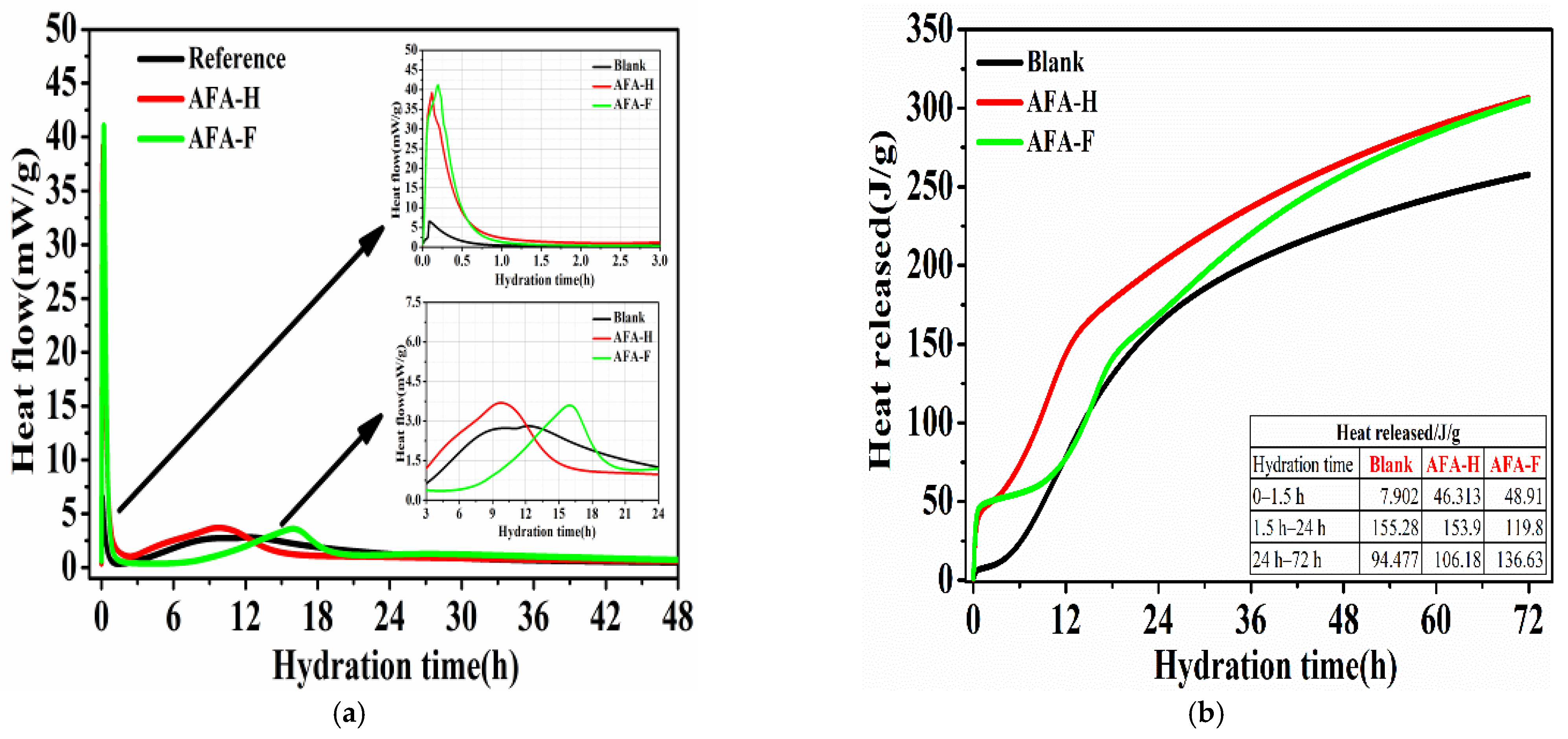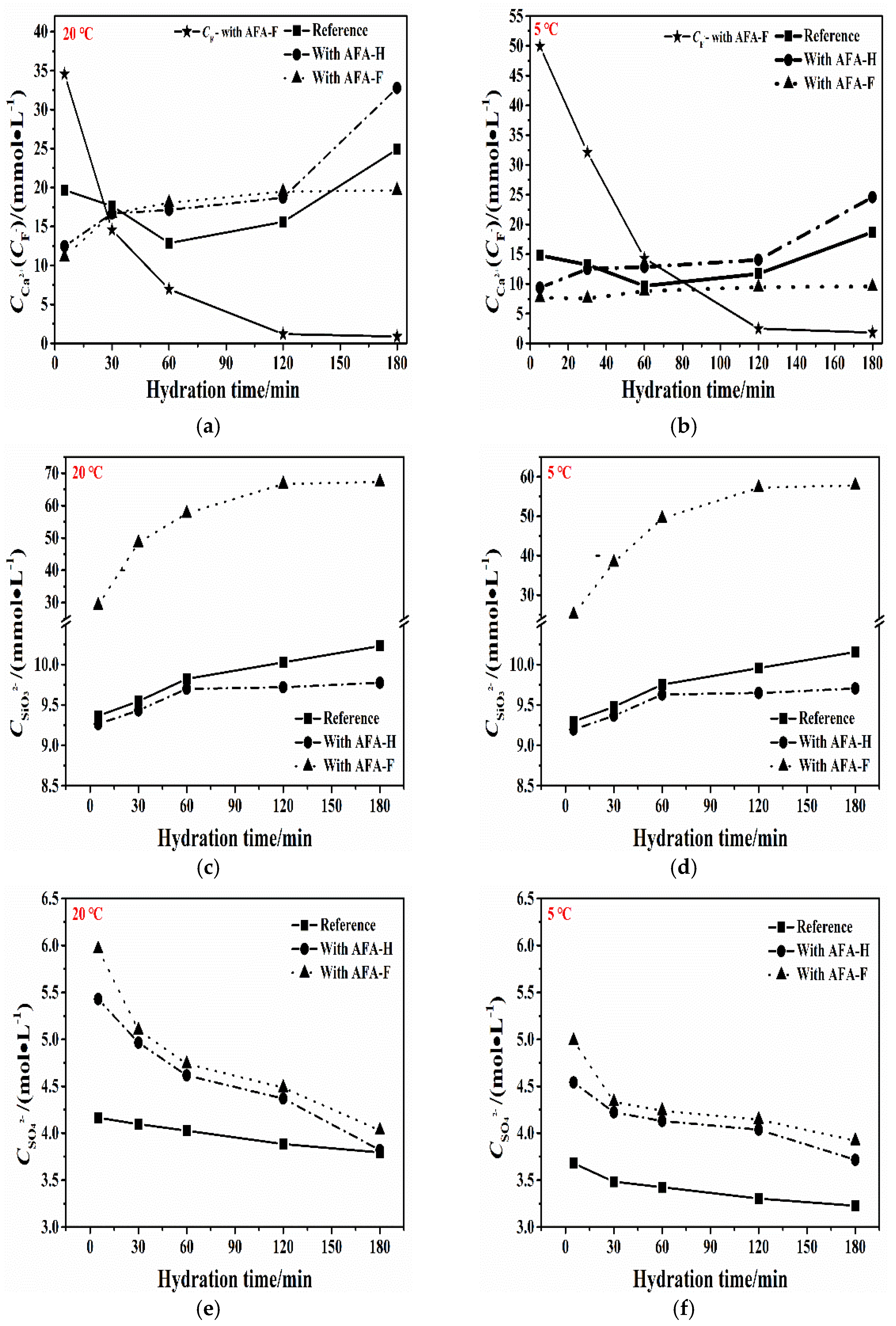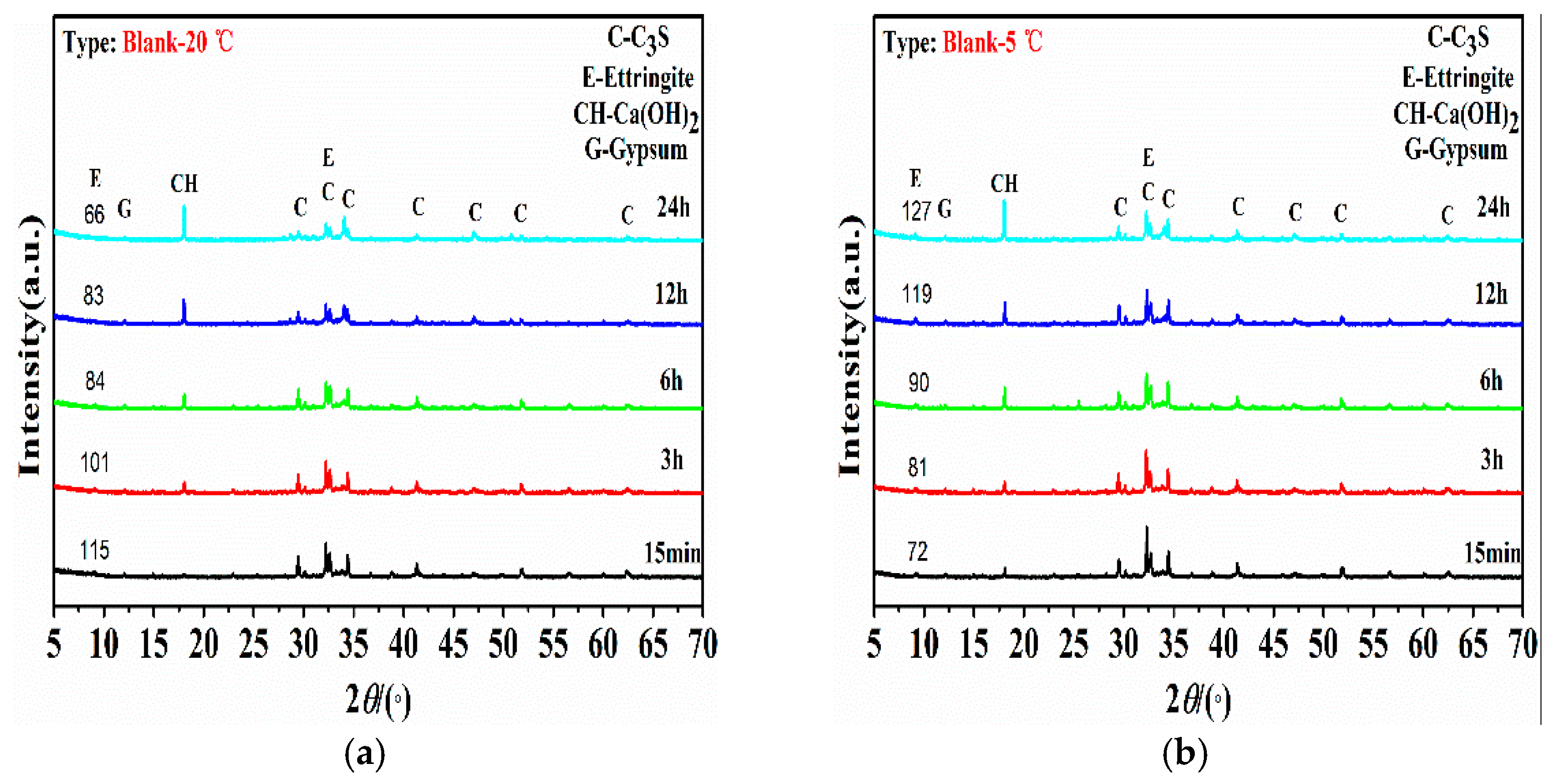The Influence of Alkali-Free Shotcrete Accelerators on Early Age Hydration and Property Development within Cement Systems
Abstract
1. Introduction
2. Materials and Methods
2.1. Materials
2.2. Synthesis of AFA Accelerator
2.3. Mix Proportion of Cement Paste and Mortar
2.4. Experimental Methods
2.4.1. Setting Time of Cement Paste and Compressive Strength of Mortar
2.4.2. Isothermal Calorimeter Test
2.4.3. Hydration Ion Leaching Concentration
2.4.4. X-ray Diffraction
2.4.5. SEM Analysis
3. Results and Discussion
3.1. Isothermal Calorimeter Analysis
3.2. Hydration Ion Leaching Concentration
3.3. Setting Time and Mortar Strength
3.4. X-ray Diffraction Analysis
3.5. ESEM Microanalysis
4. Conclusions
- (1)
- Compared with that with the non-fluoride alkali-free accelerators, alkali-free accelerators composed of aluminum sulfate and fluoride compounds promote the alite minerals dissolution and more calcium and silica ions are released in the liquid phase of the cement paste. Depending on the sufficient sulfate obtained in the setting accelerators synthesis procedure, more highly exothermic ettringite and monosulfoaluminate hydrate form quickly, hence leading to a relatively shorter setting time and coagulation effect.
- (2)
- The early age hydration process of accelerated cement pastes is delayed when the environment temperature decreased from 20 °C to 5 °C, causing a longer setting time and lower initial mortar strength. Nevertheless, in the cement system with fluorine-containing alkali-free setting accelerators, its setting performance seems to be less sensitive to the negative initial hydration effect induced by a low temperature of 5 °C, compared with that without fluorides. This phenomenon may be associated with the fact that the promoted dissolution effect of alite minerals was not disturbed and silicate ions concentration was still as high as that at 20 °C. Furthermore, quick setting hydration products like ettringite phase content were not reduced from the XRD results.
- (3)
- The initial mechanical strength of accelerated cement mortar is lower with fluorine compounds introduced into alkali-free setting accelerators. As measured by isothermal calorimetry and XRD analysis, fluorine ions are easily combined with calcium ions to form calcium fluoride products in the early hydration stage. It is observed that calcium fluoride products, which have a thin-plate shape and low structural strength, tend to intercalate with similar layered C-S-H gel hydrates and weaken the denseness of hydration products. The existence of fluorine ions promotes the conversion of ettringite to monosulfoaluminate hydrate in the accelerating period, which blocks alite dissolution sites and inhibits its further hydration, resulting in slower strength development.
Author Contributions
Funding
Institutional Review Board Statement
Informed Consent Statement
Data Availability Statement
Conflicts of Interest
References
- ACI Committee 506; Specification for Shotcrete (ACI 506.2-95). American Concrete Institute: Farmington Hills, MI, USA, 2008; pp. 1–8.
- Thomas, A.H.; Dimmock, R.H. The design philosophy for permanent sprayed concrete linings. In Proceedings of the International Symposium on Sprayed Concrete, Trondheim, Norway, 11–14 June 2018. [Google Scholar]
- Malmgren, L.; Nordlund, E.; Rolund, S. Adhesion strength and shrinkage of shotcrete. Tunn. Undergr. Space Technol. 2004, 20, 33–48. [Google Scholar] [CrossRef]
- Dressler, I.; Freund, N.; Lowke, D. The Effect of Accelerator Dosage on Fresh Concrete Properties and on Interlayer Strength in Shotcrete 3D Printing. Materials 2020, 13, 374. [Google Scholar] [CrossRef]
- Hu, Z.; Ding, H.; Lai, J.X.; Wang, H.; Wang, X.L.; He, S.Y. The durability of shotcrete in cold region tunnel: A review. Constr. Build. Mater. 2018, 185, 670–683. [Google Scholar] [CrossRef]
- Ji, Y.L.; Sun, Z.P.; Chen, C.; Pel, L.; Barakat, A. Setting Characteristics, Mechanical Properties and Microstructure of Cement Pastes Containing Accelerators Mixed with Superabsorbent Polymers (SAPs): An NMR Study Combined with Additional Methods. Materials 2019, 12, 315. [Google Scholar] [CrossRef] [PubMed]
- Galan, I.; Baldermann, A.; Kusterle, W.; Dietzel, M.; Mittermayr, F. Durability of shotcrete for underground support– Review and update; Long-term deterioration of lining in tunnels. Constr. Build. Mater. 2019, 202, 465–493. [Google Scholar] [CrossRef]
- Salvador, R.P.; Cavalaro, S.H.P.; Segura, I.; Figueiredo, A.D.; Perez, J. Early age hydration of cement pastes with alkaline and alkali-free accelerators for sprayed concrete. Constr. Build. Mater. 2016, 111, 389–398. [Google Scholar] [CrossRef]
- Paglia, C.; Wombacher, F.; Bohni, H. The influence of alkali-free and alkaline shotcrete accelerators within cement systems: I. Characterization of the setting behavior. Cem. Concr. Res. 2001, 31, 913–918. [Google Scholar] [CrossRef]
- GBT 35159; Flash Setting Admixtures for Shotcrete. Standardization Administration of the People’s Republic of China: Beijing, China, 2017.
- Salvador, R.P.; Cavalaro, S.H.P.; Cincotto, M.A.; de Figueiredo, A.D. Parameters controlling early age hydration of cement pastes containing accelerators for sprayed concrete. Cem. Concr. Res. 2016, 89, 230–248. [Google Scholar] [CrossRef]
- Wang, Y.F.; Shi, C.J.; Ma, Y.H.; Xiao, Y.C.; Liu, Y. Accelerators for shotcrete—Chemical composition and their effects on hydration, microstructure and properties of cement-based materials. Constr. Build Mater. 2021, 281, 122557. [Google Scholar] [CrossRef]
- Yang, R.H.; He, T.S. The accelerating mechanism of alkali free liquid accelerator based on fluoroaluminate for shotcrete. Constr. Build. Mater. 2020, 274, 121830. [Google Scholar] [CrossRef]
- Zeng, L.P.; Qiao, M.; Wang, W.; Ran, Q.P.; Hong, J.X. Effect of liquid alkali-free accelerators on early age hydration of portland cement. J. Build. Mater. 2021, 24, 31–38+44. (In Chinese) [Google Scholar]
- QCR 807; Liquid Alkali-Free Flash Setting Admixture for Shotcrete of Tunnels. China State Railway Group Co., Ltd.: Beijing, China, 2020.
- GBT 8076; Concrete Admixtures. Standardization Administration of the People’s Republic of China: Beijing, China, 2008.
- Kong, X.; Pakusch, J.; Jansen, D.; Emmerling, S.; Neubauer, J.; Goetz-Neuhoeffer, F. Effect of polymer latexes with cleaned serum on the phase development of hydrating cement pastes. Cem. Concr. Res. 2016, 84, 30–40. [Google Scholar] [CrossRef]
- Kong, X.M.; Lu, Z.C.; Zhang, C.Y. Recent development on understanding cement hydration mechanism and effects of chemical admixtures on cement hydration. J. Chin. Ceram. Soc. 2017, 45, 274–281. (In Chinese) [Google Scholar]
- Salvador, R.P.; Cavalaro, S.H.P.; Monte, R.; de Figueiredo, A.D. Relation between chemical processes and mechanical properties of sprayed cementitious matrices containing accelerators. Cem. Concr. Compos. 2017, 79, 117–132. [Google Scholar] [CrossRef]
- Joisel, A. Admixtures for Cement; Published by the Author: Soisy, France, 1973. [Google Scholar]
- Peng, J.H.; Lou, Z.H. Study on the mechanism of ettringite formation. J. Chin. Ceram. Soc. 2000, 6, 511–515. (In Chinese) [Google Scholar]
- Liu, X.H.; Ma, B.G.; Tan, H.B.; Gu, B.Q.; Zhang, T.; Chen, P.; Li, H.N.; Mei, J.P. Effect of aluminum sulfate on the hydration of Portland cement, tricalcium silicate and tricalcium aluminate. Constr. Build. Mater. 2020, 232, 117179. [Google Scholar] [CrossRef]
- Iljina, A.; Baltakys, K.; Bankauskaite, A.; Eisinas, A.; Kitrys, S. The stability of formed CaF2 and its influence on the thermal behavior of C-S-H in CaO–silica gel waste-H2O system. J. Therm. Anal. Calorim. 2017, 127, 221–228. [Google Scholar] [CrossRef]







| Chemical Composition (%) | Mineralogical Composition (%) 1 | ||
|---|---|---|---|
| Compound | Content | Compound | Content |
| LOI | 5.64 | C3S | 55.0 |
| SiO2 | 18.379 | C2S | 11.2 |
| Al2O3 | 4.407 | C3A | 4.7 |
| CaO | 61.956 | C4AF | 12.5 |
| Fe2O3 | 3.244 | CaSO4 | 1.2 |
| MgO | 2.434 | Ca(OH)2 | 2.8 |
| Na2O | 0.121 | CaCO3 | 0.8 |
| K2O | 0.594 | MgO | 1.1 |
| SO3 | 2.880 | SiO2 | 0.2 |
| TiO2 | 0.343 | K2SO4 | 0.7 |
| Total sum | 99.98 | CaSO4·2H2O | 0.6 |
| CaSO4·1/2H2O | 2.0 | ||
| Dolomite | 1.2 | ||
| Amorphous | 5.9 | ||
| Total sum | 99.9 | ||
| Material | Unit | AFA-F | AFA-H |
|---|---|---|---|
| Density | g/cm3 | 1.39 | 1.45 |
| Solid content | % | 49.5 | 61.3 |
| pH | / | 2.4 | 3.1 |
| Stability | mL | 3 | 1 |
| Chloride Content | % | 0 | 0 |
| Fluoride content | % | 2.7 | 0 |
| Properties | Reference Paste | AFA-H Paste | AFA-F Paste | Reference Mortar | AFA-H Mortar | AFA-F Mortar |
|---|---|---|---|---|---|---|
| Cement (g) | 400.0 | 400.0 | 400.0 | 900.0 | 900.0 | 900.0 |
| Deionized water | 140.0 | 123.8 | 127.6 | 450.0 | 413.6 | 422.1 |
| GSB 08-1337 sand | / | / | / | 1350.0 | 1350.0 | 1350.0 |
| AFA-H (% bcw) | 0 | 32 | 32 | 0 | 72 | 72 |
| AFA-F (% bcw) | 0 | 32 | 32 | 0 | 72 | 72 |
| Group | Dosage /% | Measured Temperature/°C | Setting Time/min | Compressive Strength/MPa | |||||
|---|---|---|---|---|---|---|---|---|---|
| Initial | Final | 6 h | 12 h | 24 h | 48 h | 72 h | |||
| Ref. | / | 20 | 205 1 | 315 1 | / | 1.5 | 13.5 | 25.6 | 35.7 |
| 5 | 258 1 | 425 1 | / | 0.6 | 8.5 | 13.6 | 23.5 | ||
| AFA-H | 8 | 20 | 2:10 | 5:40 | 1.8 | 5.1 | 17.4 | 22.4 | 29.1 |
| 8 | 5 | 3:30 | 8:00 | 0.5 | 2.3 | 10.2 | 16.6 | 26.9 | |
| AFA-F | 8 | 20 | 1:00 | 1:20 | 0.1 | 0.3 | 6.9 | 16.5 | 19.1 |
| 8 | 5 | 1:20 | 2:00 | / | / | 3.8 | 10.8 | 16.8 | |
Publisher’s Note: MDPI stays neutral with regard to jurisdictional claims in published maps and institutional affiliations. |
© 2022 by the authors. Licensee MDPI, Basel, Switzerland. This article is an open access article distributed under the terms and conditions of the Creative Commons Attribution (CC BY) license (https://creativecommons.org/licenses/by/4.0/).
Share and Cite
Wang, W.; Zeng, L.; Du, S.; Qiao, M.; Chen, J.; Zhu, B. The Influence of Alkali-Free Shotcrete Accelerators on Early Age Hydration and Property Development within Cement Systems. Materials 2022, 15, 6907. https://doi.org/10.3390/ma15196907
Wang W, Zeng L, Du S, Qiao M, Chen J, Zhu B. The Influence of Alkali-Free Shotcrete Accelerators on Early Age Hydration and Property Development within Cement Systems. Materials. 2022; 15(19):6907. https://doi.org/10.3390/ma15196907
Chicago/Turabian StyleWang, Wei, Luping Zeng, Shuang Du, Min Qiao, Junsong Chen, and Bosong Zhu. 2022. "The Influence of Alkali-Free Shotcrete Accelerators on Early Age Hydration and Property Development within Cement Systems" Materials 15, no. 19: 6907. https://doi.org/10.3390/ma15196907
APA StyleWang, W., Zeng, L., Du, S., Qiao, M., Chen, J., & Zhu, B. (2022). The Influence of Alkali-Free Shotcrete Accelerators on Early Age Hydration and Property Development within Cement Systems. Materials, 15(19), 6907. https://doi.org/10.3390/ma15196907




